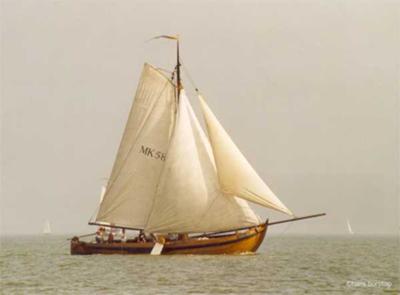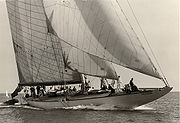Why are the Headsails the most important sails?
by Han
(Brittany, France.)

As Alex regularly points out on this site, the staysail, and in particular the genoa, provides the main source of propulsion, especially on close-hauled courses in a sailing boat.
But it's not the sail itself: the secret lies in the slit between the staysail and the main sail. Providing the staysail reaches past the centre of effort behind the mast, and the camber of the staysail-leech matches that of the main; the aerodynamic result is a remarkable acceleration of airspeed in the slit (more about this effect here: http://www.spiritus-temporis.com/venturi-effect/), deepening the low-pressure area in lee of the mainsail and thereby increasing propulsion.
About two centuries ago, it was mainly the fishermen, using fore-and-aft rigs, who began to use this effect by rigging bigger staysails, which in the Netherlands resulted in the "botterfok" (see the picture of the gaff-rigged fisherman), a staysail reaching far behind the mast; you could call it a fore-runner of the well-known genoa.
Of course people wanted more of this advantage by creating more slits. The result was the cutter-rig: the staysail got a bigger brother in front, the jib. It was often attached to a jib-stay rigged from the fixed bowsprit, but another way was to fly it, unattached to a stay, from a removable jib-boom by way of a traveller, an iron ring which could be moved fore- and backwards along the boom. This way of rigging can also be seen on the first picture.

A third kind of cutter-rig is shown in the picture of Velsheda, one of the famous J-class racers: it has neither bowsprit nor jib-boom. Her mast is placed far back, leaving room for an inner stay (used for staysail or genoa) and an outer stay, used for the jib. Above the jib a flying jib (not attached to a stay) could be hoisted.
Ever since I started writing on this site, it amazes me that the English language seems to lack different words (as in Dutch) for the different headsails, in particular those in a cutter-rig.
In my humble opinion this must cause serious communication-problems between helm and crew on a cutter. And I would like to champion the use of "jib" for the foremost staysail if and when two headsails are in use, and the use of "staysail" or "foresail" when only one is rigged.

